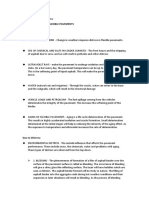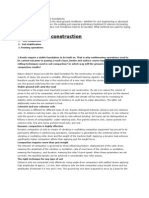100%(1)100% found this document useful (1 vote)
454 viewsClay Blanket
Clay Blanket
Uploaded by
Ahmed TarekEarthen dams are dams made of materials like clay and rock that are economical. They come in small, medium, and large sizes. Small earthen dams, which are less than 50 feet tall, are used worldwide and can have different internal structures. Approximately 30% of dam failures are due to foundation problems like unstable foundation material, dissolution, liquefaction, settlement, or uncontrolled seepage. For small dams built on streams with low flow, controlling seepage from the alluvial foundation is especially important. Different techniques for controlling seepage include cutoff walls, grouted cutoffs, impervious blankets, and increasing the seepage path by using clay.
Copyright:
© All Rights Reserved
Available Formats
Download as DOCX, PDF, TXT or read online from Scribd
Clay Blanket
Clay Blanket
Uploaded by
Ahmed Tarek100%(1)100% found this document useful (1 vote)
454 views2 pagesEarthen dams are dams made of materials like clay and rock that are economical. They come in small, medium, and large sizes. Small earthen dams, which are less than 50 feet tall, are used worldwide and can have different internal structures. Approximately 30% of dam failures are due to foundation problems like unstable foundation material, dissolution, liquefaction, settlement, or uncontrolled seepage. For small dams built on streams with low flow, controlling seepage from the alluvial foundation is especially important. Different techniques for controlling seepage include cutoff walls, grouted cutoffs, impervious blankets, and increasing the seepage path by using clay.
Original Description:
clay blanket information
Original Title
clay blanket
Copyright
© © All Rights Reserved
Available Formats
DOCX, PDF, TXT or read online from Scribd
Share this document
Did you find this document useful?
Is this content inappropriate?
Earthen dams are dams made of materials like clay and rock that are economical. They come in small, medium, and large sizes. Small earthen dams, which are less than 50 feet tall, are used worldwide and can have different internal structures. Approximately 30% of dam failures are due to foundation problems like unstable foundation material, dissolution, liquefaction, settlement, or uncontrolled seepage. For small dams built on streams with low flow, controlling seepage from the alluvial foundation is especially important. Different techniques for controlling seepage include cutoff walls, grouted cutoffs, impervious blankets, and increasing the seepage path by using clay.
Copyright:
© All Rights Reserved
Available Formats
Download as DOCX, PDF, TXT or read online from Scribd
Download as docx, pdf, or txt
100%(1)100% found this document useful (1 vote)
454 views2 pagesClay Blanket
Clay Blanket
Uploaded by
Ahmed TarekEarthen dams are dams made of materials like clay and rock that are economical. They come in small, medium, and large sizes. Small earthen dams, which are less than 50 feet tall, are used worldwide and can have different internal structures. Approximately 30% of dam failures are due to foundation problems like unstable foundation material, dissolution, liquefaction, settlement, or uncontrolled seepage. For small dams built on streams with low flow, controlling seepage from the alluvial foundation is especially important. Different techniques for controlling seepage include cutoff walls, grouted cutoffs, impervious blankets, and increasing the seepage path by using clay.
Copyright:
© All Rights Reserved
Available Formats
Download as DOCX, PDF, TXT or read online from Scribd
Download as docx, pdf, or txt
You are on page 1of 2
Earthen dams are water retaining
structures made up of earthen material like
clays and rocks. They are the most economic
dams on the basis of material. They may be
Small, Medium or Large on the basis of size of
dams. USBR (United Stated Bureau of
Reclamation) defined small dam as one having
maximum height < 15 m (50 ft.).
Small earthen embankment dams are used
worldwide. They may be homogenous, zoned
embankments or Earth cored rock filled Dams
(ECRDs.).
Dams are important engineering
structures. The failure of a dam would mean the
loss of many lives as well as economy. Table 1
shows the failures of dams occurred in the
world along with their causes. About 30% of
the dams failures occurred in the world were
due to foundation defects.
The foundation problems may be Sliding
stability of foundation material, dissolution of
foundation material, liquefaction, differential
settlement/ deformation of foundation material
and/or uncontrolled foundation seepage.
Seepage control is of prime importance in
case of small dams because these dams are
constructed on streams of low discharge and
smaller catchment areas where the availability
of water is minimal. Seepage may occur from
139
Journal of Himalayan Earth Sciences Volume 48, No. 2, 2015 pp.139-147
Table 1. Causes of failure of dams in the world
(Thomas, 1976).
140
dam body, abutments or foundation bed
(Asawa, 2006). To control seepage from the
dam body, the thickness of clay core must be
enough to lower the piezometric line to a safe
level like downstream horizontal drain or toe
drain where the pressure is atmospheric.
Seepage from the abutments can be controlled
using available methods like grouting and
escarpment if the problem exists.
The streams on which small dams are built,
most often have bed rock at a higher depth. The
foundation bed over there is of alluvial material
of pervious nature. In such case the control of
seepage from alluvial bed is of prime
importance. If the bed rock is at shallow depth,
a cut off trench/wall as in Figure 1a is the best
solution (Novak et al., 2007). Grouted cutoffs
and diaphragm cutoff walls as in Figure 2b and
Figure 3c are other solutions to the problem.
For the case when rock is at higher depth,
upstream impervious blanket (Fig. 3d) is the
best choice (ICOLD, 2011). In all afore
mentioned methods, the basic technique is to
increase the seepage path. In the last mentioned
alternative, clay is used as a construction
material for this purpose, due to its economy
and availability.
You might also like
- Flood: Estimation For Small East African Rural CatchmentsDocument14 pagesFlood: Estimation For Small East African Rural CatchmentsafbafbNo ratings yet
- Earth EmbankmentDocument26 pagesEarth EmbankmentPutri ArumsariNo ratings yet
- CV PonsianoDocument5 pagesCV PonsianoJonah ScottNo ratings yet
- Embankment Dam EngineeringDocument42 pagesEmbankment Dam EngineeringMussaNo ratings yet
- CD WorksDocument35 pagesCD WorksThulasidharan Nair Bhaskaran100% (2)
- Lining CanalDocument39 pagesLining CanalAastha SoniNo ratings yet
- River Training Works - Case Studies of Ganga Bridge No. 52: Project Report ONDocument72 pagesRiver Training Works - Case Studies of Ganga Bridge No. 52: Project Report ONRam NepaliNo ratings yet
- G 2Document183 pagesG 2vpmohammedNo ratings yet
- Diversion HeadworkDocument112 pagesDiversion HeadworkMargaret Abraham CENo ratings yet
- Chapter FiveDocument16 pagesChapter FiveKefene GurmessaNo ratings yet
- 20 - Earthen Dams and Rockfill DamsDocument54 pages20 - Earthen Dams and Rockfill DamsEmanuelRodriguezElera100% (1)
- TUNNEL PresentationDocument27 pagesTUNNEL Presentationsanket jainNo ratings yet
- Cross Drainage WorkDocument13 pagesCross Drainage WorkAtish Kumar100% (3)
- Hill Roads 073 OldDocument22 pagesHill Roads 073 OldRajesh KhadkaNo ratings yet
- Types of Failures in Flexible and Rigid PavementsDocument6 pagesTypes of Failures in Flexible and Rigid PavementsTrisha Mae Jamili PetillaNo ratings yet
- Signal Design Using Webster'S Method (4 Legged Intersection)Document7 pagesSignal Design Using Webster'S Method (4 Legged Intersection)Nor Hidayah Mohd RazaliNo ratings yet
- Causeways: Figure 1 Causeways With Low Volume Flow and in FloodDocument14 pagesCauseways: Figure 1 Causeways With Low Volume Flow and in FloodAnil MarsaniNo ratings yet
- FerroDocument129 pagesFerrosureshrakesh0% (1)
- Galleries in Gravity Dams:: Foundation GalleryDocument2 pagesGalleries in Gravity Dams:: Foundation GalleryAchyutha Anil100% (1)
- Design Criteria of Stilling BasinDocument22 pagesDesign Criteria of Stilling Basinjagmeet singh100% (1)
- CE-402: Irrigation Engineering: 8 Semester (4 Year) Civil Engineering Spring 2021Document23 pagesCE-402: Irrigation Engineering: 8 Semester (4 Year) Civil Engineering Spring 2021SajadNo ratings yet
- Return Period & Others GuidelinesDocument1 pageReturn Period & Others GuidelinesHarish Kumar Mahavar100% (1)
- Canal Design RequirementDocument10 pagesCanal Design RequirementAvinash Sahu100% (1)
- Culvert and BridgeDocument16 pagesCulvert and BridgeAljondear RamosNo ratings yet
- Well Foundation PDFDocument41 pagesWell Foundation PDFpeterNo ratings yet
- Final Project Design of Diversion Structure: Faculity of Civil and Water Resource EngineeringDocument76 pagesFinal Project Design of Diversion Structure: Faculity of Civil and Water Resource EngineeringReffisa JiruNo ratings yet
- Chapter 8 Culverts&Low Level Water CrossingsDocument9 pagesChapter 8 Culverts&Low Level Water CrossingsTajura TamiraatiNo ratings yet
- Lecture-8 Fluming & CROSS-DRAINAGE WORKSDocument32 pagesLecture-8 Fluming & CROSS-DRAINAGE WORKSqasimhassanietNo ratings yet
- Introduction Classification Advantages and Disadvantages Site Selection Selection of Type of DamDocument30 pagesIntroduction Classification Advantages and Disadvantages Site Selection Selection of Type of DamKubaNo ratings yet
- Types of Tube Wells 1. Strainer Type Tube WellsDocument4 pagesTypes of Tube Wells 1. Strainer Type Tube WellsYasin ShahNo ratings yet
- Concept of Class 9 EqvtDocument2 pagesConcept of Class 9 EqvtBijay Krishna DasNo ratings yet
- Construction Steps of Flexible PavermentDocument6 pagesConstruction Steps of Flexible PavermentE5 Sec - DW & CE [Army]No ratings yet
- Class Notes SpillwayDocument7 pagesClass Notes SpillwayIcegroup Coaching100% (1)
- River TrainingDocument8 pagesRiver Trainingnandi_scrNo ratings yet
- Design Principle of Gabion Retaining WallDocument11 pagesDesign Principle of Gabion Retaining WallAbhilash AbhiNo ratings yet
- BPT !Document17 pagesBPT !Dilip D SNo ratings yet
- Bearing Capacity by Abhishek SharmaDocument116 pagesBearing Capacity by Abhishek SharmaAbhishek Sharma100% (1)
- Road LayersDocument21 pagesRoad Layersapi-19889358No ratings yet
- Chapter - 7 - Water - Logging and DrainageDocument38 pagesChapter - 7 - Water - Logging and DrainagePrakash LamaNo ratings yet
- Design of Embankment DamDocument5 pagesDesign of Embankment DamdsanandaNo ratings yet
- River Engineering - 1Document36 pagesRiver Engineering - 1Edu4civil EngineeringNo ratings yet
- Rock Fill DamsDocument27 pagesRock Fill DamsArsalan AhmadNo ratings yet
- 8 - River Their Behaviour Control and TrainingDocument30 pages8 - River Their Behaviour Control and TrainingKomal MeenaNo ratings yet
- Dam - Foundation - Drains - Grout - Curtain - Design of GravitydamsDocument15 pagesDam - Foundation - Drains - Grout - Curtain - Design of GravitydamsAwais AliNo ratings yet
- Unit VI Chapter 12-River Training Structures (2 Lectures) SyllabusDocument17 pagesUnit VI Chapter 12-River Training Structures (2 Lectures) SyllabusAnirudh ShirkeNo ratings yet
- Highway Drainage 0734Document209 pagesHighway Drainage 0734Rajesh Khadka100% (1)
- Arch DamsDocument8 pagesArch DamsNikhil PhulNo ratings yet
- Geological Report of Caving/Loose Fall/ in Escape Tunnel at Kundan Between Chainage 12225.86 - 12227.86 M, T-49B Project, J&KDocument3 pagesGeological Report of Caving/Loose Fall/ in Escape Tunnel at Kundan Between Chainage 12225.86 - 12227.86 M, T-49B Project, J&KBilal MirNo ratings yet
- NPTEL Concrete Engg and Tech Problem and Solved AnswersDocument5 pagesNPTEL Concrete Engg and Tech Problem and Solved AnswerssuranjanacNo ratings yet
- On Design of A Aqueduct - Cross Drainage WorkDocument53 pagesOn Design of A Aqueduct - Cross Drainage WorkShibani Patel90% (10)
- Pipe CulvertDocument12 pagesPipe CulvertveevimalNo ratings yet
- Lec 7 Design of Stilling BasinDocument135 pagesLec 7 Design of Stilling Basinshahid aliNo ratings yet
- Dam & Reservoir Site Selection Guidelines & CriteriaDocument7 pagesDam & Reservoir Site Selection Guidelines & CriteriaRosxannieVilaNo ratings yet
- Manual - Lining - Irrigation - Canals - West BengalDocument22 pagesManual - Lining - Irrigation - Canals - West Bengalsudheer7320_58503644No ratings yet
- Stilling BasinsDocument5 pagesStilling BasinsDjHanna OlShopsNo ratings yet
- Types of EarthdamsDocument21 pagesTypes of EarthdamsDilipKumarAkkaladeviNo ratings yet
- Irrigation Engineering and Hydraulic Structure Santosh Kumar GargDocument165 pagesIrrigation Engineering and Hydraulic Structure Santosh Kumar GargAnand RatnaNo ratings yet
- Main ProposalDocument12 pagesMain ProposalAbhay SuwalNo ratings yet
- Seepage Dams - Presa LagunaDocument10 pagesSeepage Dams - Presa LagunaLiamNo ratings yet
- Geology of Embankment DamsDocument17 pagesGeology of Embankment DamsIchipi-ifukor Patrick ChukuyenumNo ratings yet
- Seismicity in Dam EngineeringDocument51 pagesSeismicity in Dam EngineeringomeaveNo ratings yet
- 11.session 5 - Failure Modes For Concrete DamsDocument166 pages11.session 5 - Failure Modes For Concrete DamsAlex BaciuNo ratings yet
- Assessment of Monar Arch Dam Under Extreme Seismic and Thermal LoadsDocument11 pagesAssessment of Monar Arch Dam Under Extreme Seismic and Thermal LoadsAnonymous mJNbkg1C0No ratings yet
- Channel ImprovementsDocument18 pagesChannel ImprovementsCiano VelasquezNo ratings yet
- The Causes of Floods.Document5 pagesThe Causes of Floods.Delmy Elizabeth Fuentes NuñezNo ratings yet
- MYCOLD Dam Safety Training Exercise No. 3Document5 pagesMYCOLD Dam Safety Training Exercise No. 3Muhamad HafizNo ratings yet
- Design Parameters Report: Vishnugad Pipalkoti Hydro Electric Project (4 X 111 MW), THDC, Rishikesh, IndiaDocument58 pagesDesign Parameters Report: Vishnugad Pipalkoti Hydro Electric Project (4 X 111 MW), THDC, Rishikesh, IndiaShivendra KumarNo ratings yet
- Failure Investigation of Tawila Dam in North DarfurDocument4 pagesFailure Investigation of Tawila Dam in North DarfurBoos yousufNo ratings yet
- Natural Resource ManagementDocument10 pagesNatural Resource ManagementDarshit RanderNo ratings yet
- Check Dams Erosion ControlDocument6 pagesCheck Dams Erosion ControlAziz Khan KakarNo ratings yet
- Visualizingthe Impactof Concurrent Delays 2020Document20 pagesVisualizingthe Impactof Concurrent Delays 2020Luis Danilo Coronel ArmasNo ratings yet
- E Book 3rdNationalWaterWeekDocument96 pagesE Book 3rdNationalWaterWeekHari Harul VullangiNo ratings yet
- Water Governance in A Cultural Context-Hydrotheek (Stowa) 244223Document10 pagesWater Governance in A Cultural Context-Hydrotheek (Stowa) 244223Sanja LoncarNo ratings yet
- Evs Set 2 AssgnDocument17 pagesEvs Set 2 Assgnabhi abhiNo ratings yet
- Design Hydropower PlantDocument49 pagesDesign Hydropower PlantManuel Contreras100% (1)
- Exit Exam Questions - CoTM - April 2024Document11 pagesExit Exam Questions - CoTM - April 2024Wondemeneh Asrat100% (2)
- 32 - C - 1 Social ScienceDocument23 pages32 - C - 1 Social ScienceTaniya NaagarNo ratings yet
- Water Power EngineeringDocument18 pagesWater Power EngineeringRJNo ratings yet
- Modelling of Water Allocation and Availability in Devoll River Basin, AlbaniaDocument9 pagesModelling of Water Allocation and Availability in Devoll River Basin, AlbaniaAli FakhriNo ratings yet
- Time-Dependent Deformation in High Concrete-Faced Rockfill Dam and Separation Between Concrete Face Slab and Cushion LayerDocument15 pagesTime-Dependent Deformation in High Concrete-Faced Rockfill Dam and Separation Between Concrete Face Slab and Cushion LayerSamoon IbrahimNo ratings yet
- Federal Energy Regulatory Commission - June 28, 2024 FilingDocument3 pagesFederal Energy Regulatory Commission - June 28, 2024 FilingGage GouldingNo ratings yet
- Module 1 Notes RESDocument19 pagesModule 1 Notes RESrahulkmrahulkm45No ratings yet
- Characteristics of Copper Tailings in Direct Simple Shearing - A Critical State ApproachDocument17 pagesCharacteristics of Copper Tailings in Direct Simple Shearing - A Critical State Approachgabriela.p.alfaro.aNo ratings yet
- Water Code (PD 1067)Document10 pagesWater Code (PD 1067)Bory SanotsNo ratings yet
- Sustainable Mining Practices - A Global PerspectiveDocument312 pagesSustainable Mining Practices - A Global PerspectiveBwalya BwalyaNo ratings yet
- Social x Cbse Pre-board 2 Ms (Set-1) 2023-24Document16 pagesSocial x Cbse Pre-board 2 Ms (Set-1) 2023-24aasrcreationNo ratings yet
- Earthquake Analysis, Desing, and Safety Evaluation of Concrete Gravity DamsDocument85 pagesEarthquake Analysis, Desing, and Safety Evaluation of Concrete Gravity DamsIng Javier RiosNo ratings yet
- Presentation 1Document109 pagesPresentation 1keethanNo ratings yet
- Summary Tailings DesignDocument1 pageSummary Tailings DesignChamel “cham” RuperezNo ratings yet

























































































